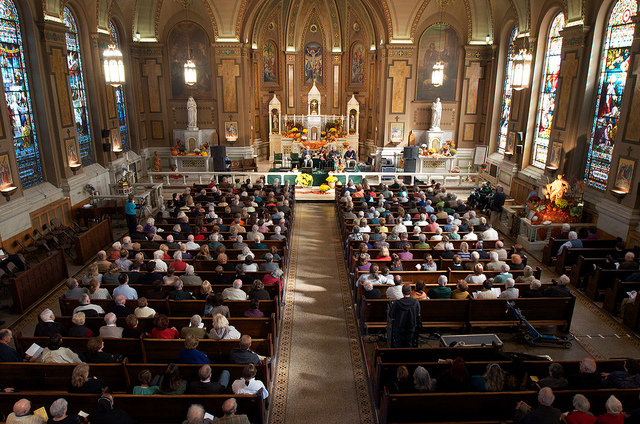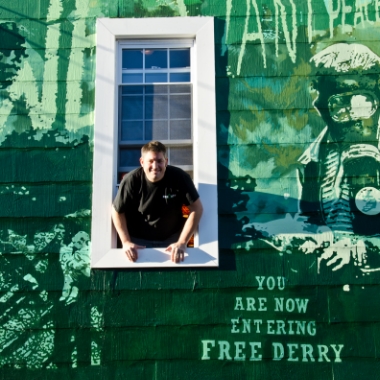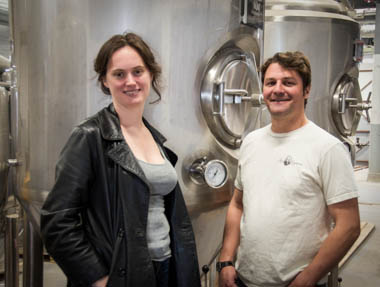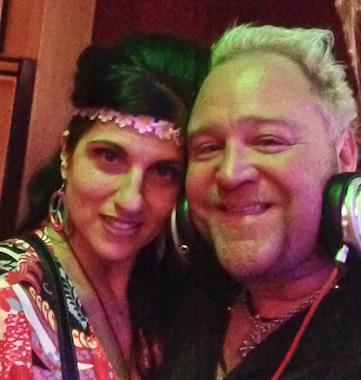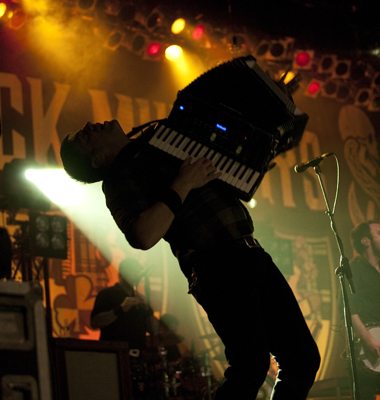
Dropkick Murphy's Tim Brennan.
If you’re thinking about switching energy suppliers, you might want to consider the Dropkick Murphys. This Celtic punk band did two shows this week at Philadelphia’s Electric Factory and it couldn’t have been a more apt location for this wild, working man’s group born in the basement of a barbershop in Quincy, Massachusetts in 1996.
It didn’t take long for the Dropkicks to bust out of suburban Boston. They were signed by Hellcat Records in 1998 and by the early 2000s you didn’t need to be a punk aficionado to have heard them. Their reworking of an old Boston Red Sox song, “Tessie” made the soundtrack of the Drew Barrymore-Jimmy Fallon movie “Fever Pitch” and it continues to be played at Red Sox games after the team wins. (It was Red Sox closer Jonathan Papelbon’s walk-up song too—and he occasionally performed a little jig when it played). A second tune, “I’m Shipping Up to Boston” with lyrics by the late Woody Guthrie, was featured in the 2006 Academy Award-winning Martin Scorsese film, “The Departed” and on an episode of “The Simpsons” called “The Debarted.” If you attended the Boston Bruins-Philadelphia Flyers 2010 NHL Winter Classic in Fenway Park in Boston, you would have heard them perform it live, though if you’re a Flyers fan, you might not have cheered.
You certainly wouldn’t have crowd-surfed or leaped into a writhing mosh pit, but that’s what fans were doing at the group’s two shows this week. We know because our own Brian Mengini was there, taking notes (he interviewed lead guitarist, accordian player and vocalist—and former DKM merchandise guy–Tim Brennan before the show). Most important, he took photos!
Here’s Brian’s interview. See his photos here.
What inspired you to pick up the accordion?
When I became a teenager, probably 14 or 15, I started getting re-acquainted with the Irish music that I had heard from my grandparents when I was a kid and I got really into it, especially the Pogues, and wanted to be able to play along to it with something other than a guitar. So, I bought a tin whistle and taught myself how to play that. At the time, I was playing drums in a band with some friends and I was at practice one day in my friend’s basement and his father had an accordion and I was like, “does he use that?” and he said no, its been in the basement forever. So I asked him if I could borrow it and I took it home and just kind of fiddled around for a while and started learning some songs and now here I am playing it for a living.
Now what’s been your biggest obstacle or hurdle in terms of transitioning from the merch end into the band?
No obstacles. I mean, ever since I was a kid, I knew I wanted to play music and the fact that the guys in the band recognized that although I was slinging their t-shirts that I could still play a few tunes and asking me to play with them, that was just an honor and the fact that I am here today as the lead guitar player, quote unquote, is unbelievable and the fact that I can say I started out as an assistant to a merch guy for the band is pretty…rags to riches.
Where was the first show you did with them as a guitarist?
I don’t remember exactly where it was. We went over and did a UK/European tour. That was the first one where I was playing guitar and Jeff DeRosa [DKM’s news member] was in the band. It seems like it was so long ago but it wasn’t that long ago.
What groups would we find on your iPod?
There is a lot of different stuff then you would think. I mean there is the obvious ones like the Pogues and the Clash but there’s a lot of the Stones and Chuck Berry and Ryan Adams and Hank Williams. Everything from older country stuff to whatever great new independent bands are out there.
How is it performing in Boston for St Paddy’s Day?
It’s amazing. We tour and all then to come back home and do a show, it’s amazing. You’re family and friends are there. It’s a great energy.
Are you guys doing the Boston parade?
No, this year we are just going to watch. With all the things we have going on around it, we are going to take it easy and just watch it this year.
What’s the biggest difference between the new CD, “Going Out In Style,” and “The Meanest of Times?”
Musically, I feel that we have matured. Also, for this album, we brought on a producer to do things vs us just doing it ourselves.
Do you feel that you will go that route again?
Yes, definitely. I think it is great. We are very happy with it!
It’s been 4 years since the last record dropped. Before that, it was about every 2. Why did this one take longer?
We had a fairly significant line up change. One of our guitar players ended up leaving the band. So I had to switch my instruments around and we acquired Jeff DeRosa, our newest member. We took a little while to make sure Jeff new all the old songs and everything. Then we started writing. But people wont have to wait that long again. I can promise that.
What’s your favorite track off the new album?
Broken Hymns. It’s not your typical Dropkick song or what you are used to. It’s a lot slower. But I like it.
What’s your favorite Irish drinking song?
I really like Waxie’s Dargle – the Pogues version from “Red Roses from Me.” There are a lot of Dubliners songs that are awesome as well.
If you could share the bill with one band, any genre, which would it be?
It’s funny because we’ve gotten to a point where a lot of the bands that we would have said, we’ve gotten to tour with. We’ve toured with the Pogues and the Sex Pistols. It would never happen because there is no way a band could ever open for them but I would say the Bruce Springsteen and the E-Street Band. They would blow us off the stage.
When did you guys find out you were performing at the 2010 NHL Winter Classic?
There were discussions about it but we found out probably a couple weeks before hand and I mean just like anything else that we’ve been involved with whether it be the Red Sox or “The Departed” or whatever, the fact that people even bounced our names around with the idea of inviting us to show is incredible. We were honored to be a part of that.
What is the process when DKM creates new material? Do ideas just come to you or do you go after a certain topic or subject matter?
As far as lyrics go, Ken & Al… we hope that inspiration strikes them as far as song writing and now and again some of the rest of us will have lines or something that we will throw in there. I deal mostly with the music writing. As far as how the songs come about, whether it starts with a vocal melody or a line or a guitar riff, someone will bring something in and we just try to flush it out as a band sometimes. Sometimes someone will come in with a complete song or sometimes it’s just a part. But, we’ve worked with each other long enough that we can sort of finish each other’s ideas when it comes to that stuff musically. As far as writing songs, we just say let’s write some songs and we all get in a room and try to hammer it out.
What’s the most grueling part of making a new album?
I mean we went into the studio in October so probably in August we would go to the practice space in Boston and we would be there for probably about 10 hours a day, just playing acoustics. We wrote some stuff at Matt Kelly’s house, our drummer’s house in his kitchen just playing acoustics. So for the first two months, we were probably just playing everything for hours and hours and hours on acoustic guitars. Then, a couple of weeks before we went into the studio or a month before we went into the studio, we started doing everything louder like it was going to be and fleshing everything out there. So I mean, the process as far as pre production then going into the recording studio was fairly grueling I guess you can say but ya know, it’s what we do. It’s what we like to do so we’ll sacrifice a couple of months of us sitting in a room with no windows and writing songs in order to get a final product.
For St. Paddy’s Day weekend, what are some of the things to do or some of the things to hit in Boston?
There is so much stuff you can do. If there are history buffs, there are plenty of historical sites around. For Dropkicks fans, there are plenty of places that we talk about in songs. It’s good to go out and see the whole city. The city itself is small so you can see a lot in a small amount of time. Then venture on down south to south Boston and it has plenty to offer. That’s for sure!
You guys are playing the House of Blues for the St. Patrick’s holiday.
We’re doing three shows at the House of Blues – Wednesday, Thursday and Friday. Saturday, we are doing an arena show in Lowell, which is going to be incredible and then on Sunday, we are doing a small club show just outside of Boston.
What’s the best place for a pint in Boston?
We always have good times at McGreevy’s. Also, there are a bunch of good dive bars in south Boston.
You were saying earlier about your process for creating new content. Have you guys ever just showed up at a party or somebody’s house and just jammed? I saw a video on YouTube with the lead singer and the guitarist from Shinedown, were at a party in someone’s house and were doing some songs acoustic, like a cover of Simple Man. It was very cool and pure.
No, you know what; we’ve never done that before. I think that would be a fun thing to do though. I feel that would be a fun thing to do as we are writing new stuff, like if you have ever seen that documentary on Jerry Seinfeld and he’s getting rid of his old material and just writing all this new stuff. So, while he is writing it, he is popping into these tiny clubs and doing sets just to test out the new stuff. I would love to do something like that if we were writing a new record and just showed up to a couple of bars in Boston and played some acoustic sets. That would be amazing! Good idea!
Which is your favorite team – Celtics, Bruins, Sox or Flyers?
The Celtics.
Better food – clam chowder or Philly cheesesteak?
Philly cheesesteak.
Brian Mengini is a professional photographer–and a music lover–from the Philadelphia area. Visit his website at http://www.bmengini.com/.

